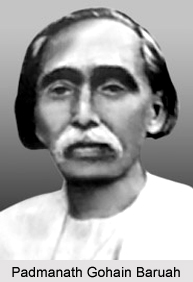 Padmanath Gohain Baruah had a multidimensional life which was not confined only in literary world. A reputed teacher, social organiser and reformer he was an active member of Asomiya Bhasar Unnati Sadhini Sabha which later gave birth to Asom Sahitya Sabha. He was instrumental in expanding the Sabha in Assam. While he was a teacher at Kohima he founded a branch of the Sabha at Naga Hills.
Padmanath Gohain Baruah had a multidimensional life which was not confined only in literary world. A reputed teacher, social organiser and reformer he was an active member of Asomiya Bhasar Unnati Sadhini Sabha which later gave birth to Asom Sahitya Sabha. He was instrumental in expanding the Sabha in Assam. While he was a teacher at Kohima he founded a branch of the Sabha at Naga Hills.
Early Life of Padmanath Gohain Baruah
Padmanath had the genius to ransack the educational domain who went to Kolkata in the last part of the 19th century to pursue higher study. His voyage started off as he became an active member of Asomiya Bhasar Unnati Sadhini Sabha, established by a number of Assamese students for the uplift of Assamese language and literature. However fate had her plans ready for him and he could not complete his BA examination but there he learnt the lesson of nationalism. His retreat to homeland witnessed his dedication for the noble cause of the uplift of his mother tongue and wrote a number of books in various styles and forms.
The school education of Padmanath started in a Bengali medium school at his birthplace Nakari near North Lakhimpur town. By then the British government had actually introduced Bengali as the vernacular language in the schools of Assam replacing Assamese in 1836. After relentless effort of a number of nationalist leaders Assamese was reinstated in 1872. But want of textbooks created another problem in Assamese medium schools of the State. To solve the problem Padmanath with his friend Panindranath Gogoi wrote a number of textbooks in Assamese language. But untimely death of Panindranath led Padmanath to complete the mission alone. To meet the necessities of the Assamese students and teachers he wrote a number of textbooks on history, geography, moral science, teachers hand book and a book on physical exercise including life and works of many stalwarts of Assamese Society. He also edited Jivani Sangrah, a rare book in Assamese literature.
Literary Career of Padmanath Gohain Baruah
He is also acknowledged as the foremost president of Asom Sahitya Sabha, the leading literary organisation of Assam. He has immense contributions to the domain of Assamese language and literature. He is also revered as a founder of modern Assamese novel. His novel Lahori, published in 1892 is the first Assamese novel. From literary point of view it is regarded as the first Assamese novel. His other novel is Bhanumoti. He also wrote a number of dramas. He wrote historical dramas like Joymoti, Gadadhar, Lachit Borphukan and Sadhani. He wrote a mythological drama called Ban Raja which was based on the legendary love story of Usha and Aniruddha. His social drama Gaonburha is based on the economic condition of Assamese people under the British rule. His comedies are: Teton Tamuli and Bhoot Ne Bhram. He is also credited to have written a monumental work: Sri Krishna. He has presented Lord Krishna as a multi faceted personality. Padmanath Gohain Baruah (1871-1946) has a blank verse epic to his credit: Lila (1901). It is written in the manner of a personal elegy on the death of his wife. However it failed to reach the heights instead crippled. His other work is the lyrical collection Jurani (1900). Gohat presents a contrast between human society and solitude of nature. In Kartabya, plants and creepers sing with the sun rays in praise of God. However the other poems in Jurani are bereaved of colour and vision, insight and glow. It lacks the qualities that give the lyric poetry grace and passion.
Journalistic Career of Padmanath Gohain Baruah
A flag carrier of journalism progress in Assam, Gohain Baruah was closely allied with a number of Assamese journals and magazines. While studying in Kolkata, he with Krishnaprasad Duwara brought out an Assamese monthly called Bijulee. Later he became its editor and ran it for more than three years. In 1901 he with Joydev Sarma published a weekly called Asom Banti from Tezpur. At a most critical period Asom Banti played a leading role in Assamese language and literature. Acting as a mouthpiece of Assamese society it brought to the focus many important issues to the British government. In 1906 Gohain Baruah published a monthly called Usha. Many stalwarts like Hem Chandra Goswami, Satyanath Bora, Sarat Chandra Goswami etc. regularly wrote in the magazine that heralded a new era in Assamese literature.



















